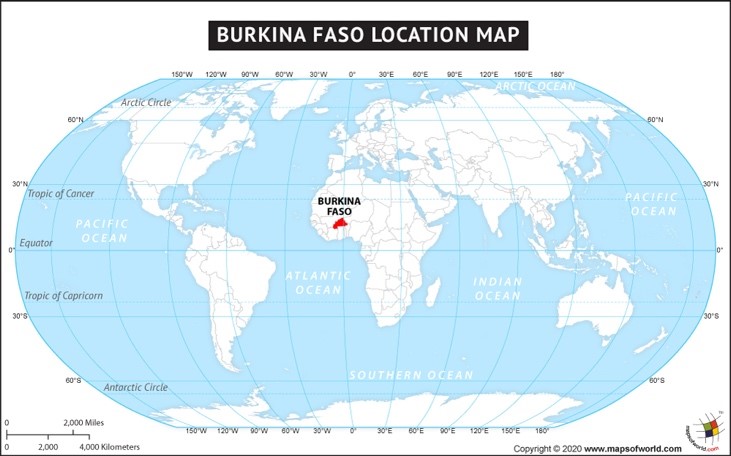
Customs and Cuisine of Burkina Faso
FAST FACTS
Location: Burkina Faso is a landlocked country in West Africa. It is bordered by Mali to the north and west, Niger to the northeast, Benin to the southeast, and Côte d’Ivoire, Ghana, and Togo to the south.
Name Origins: The country was known as Upper Volta when it was a French colony. Despite gaining independence in 1960, it was not until 1984 that it was renamed Burkina Faso. Deriving from Mooré (Burkina = free man) and Dyula (Faso = land), Burkina Faso means the “land of the upright men” or as the country of incorruptible/honest people.
Population: The population estimate for July 2020 was 20.8 million. The population is ethnically diverse, with over 60 different ethnicities with their own language, style of residences, and traditions. The dominant ethnic groups, the Mossi, the Voltaic, and the Mande are all of West African origin. The Mossi are an ethnic group who are thought to have descended from warriors who migrated into Burkina Faso from Northern Ghana around 1100 AD.
Religion: The dominant religion is Islam with about 61 percent of the population identifying as Muslim, per data from 2010. Close to 30 percent of the population are Christian, with about 23.3 percent identifying as Roman Catholic and 6.5 percent as Protestant. According to the Ministry of the Culture, 50 percent of the rural population is animist.
Language: French is the official language; however, it is not the most widely spoken language. Moore, the language of the Mossi, is the most commonly spoken language, while Dyula is a close second, with 68 other ethnic languages/dialects spoken in Burkina Faso.
CLAIM TO FAME/INFAMY
Burkina Faso was known to be a country that was free of conflict and an oasis of peaceful coexistence among the Muslims and Christians who lived there. This is especially striking given that the country is in a region (Sahel) that is characterized by ongoing strife. This changed when Islamist armed groups who were operating in Mali and Niger, neighbors of Burkina Faso, infiltrated into Burkina Faso. Since mid-2018, these groups have carried out violent attacks in Burkina Faso targeting churches, schools, and health centers. Counter-terrorism operations by the Burkinabe security forces have hurt the Burkinabe even further. Civilians assumed to be sympathetic to Islamist armed groups have been targeted by the Burkinabe security forces with more than half of their attacks recorded against other civilians.
Burkina Faso is among the poorest countries in the world. Ranked eighth among the poorest nations in the world, Burkina has been in a state of crisis due to several confounding factors. The armed violence, droughts, and COVID-19 have worked together to unfortunately worsen living conditions in the country. Healthcare facilities and schools have been targeted by armed groups making access to treatment and education harder than ever. Since July, it is estimated that more than 16 schools have been burned down, thus removing access to education for the children, not just now, but possibly for some time to come.
As a result, Burkina Faso is ranked third (2019) among the Norwegian Refugee Council’s (NRC) annual list of “Ten Most Neglected Displacement Crises in the World.” The NRC’s list is a compilation of countries that are in the midst of a displacement crisis that is extremely severe but either forgotten or absent from worldwide media mentions and/or receiving inadequate humanitarian aid. Close to a million people are estimated to have been displaced since the start of conflict in Burkina Faso.
THE BURKINABE
The people of Burkina Faso are known as the Burkinabe. With over 59 different ethnicities, the Burkinabe are a diverse group of people. This diversity is reflected in different aspects of life, including the kind of dwellings they reside in and the structure of the village. The Burkinabe of Turka ethnicity in Malon, for instance, live in villages that seem to be an organic cluster of dwellings with no specific or discernible pattern to the clustering. The Mossi ethnicity living in Koubri however, have villages that are clustered together in a specific pattern to protect against predatory animals and rival tribes. The villages are also walled off or attached to a larger village that serves as its line of defense.
The social structure varies likewise. In the Kasena ethnicity, generations live together in a group of distinct dwelling structures clustered together. The elderly or older married couples live in a hut formed in the shape of the number eight. Younger married couples with children live in the second hut in the cluster which is rectangular. A round hut with hay roof houses the bachelors. Unmarried young women stay with the grandmother or mother until they get married.
Polygamy continues to be practiced in Burkina Faso. In the Lobi tribe, the dwellings are tiered structures with the room below being the space the woman lives in and the room above reserved for when the man visits. Each wife tends to have her own hut and the women’s huts are circular in shape. The man lives in his own hut which is square or rectangular in shape. The first wife’s hut is further distinguished from the rest through the presence of a grinder. The other wives are to use the grinder at the first wife’s hut for preparing meals.
Across all ethnicities/tribes, all the villages have a communal space, either within the village cluster itself or just outside. In some villages, these take the form of a built structure. In others, it could be as simple as a large clearing with sufficient shade from the canopy of trees. Likewise, all villages have places of worship for one or all of its three main religions: Islam, Christianity, and Animism. Churches, Mosques, a talisman or sacred place for offerings are present in every village, sometimes all three are present in peaceful coexistence.
The buildings are made of adobe and hay. Men are tasked with constructing the dwellings while women paint them. Five different pigments are used, and a final polish is applied that ensures that the painting is good for up to 5 years. Buildings constructed of cement are beginning to crop up but are very few and far in between.
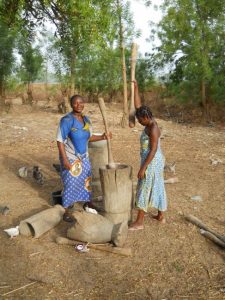
Burkinabe women pounding millet for Tô
Women are the responsible for all the daily duties associated with caring for the home and the family. This includes walking several miles to fetch water, gathering firewood, and pounding millet that goes toward making the staple “Tô,” cooking, cleaning, and caring for the children. Women are also involved in making and selling of street food, “dolo” (a beer-like alcoholic drink), and soap. The men are responsible for tending to the fields and harvesting the yield and (to a much lesser extent) raising livestock. Almost 85 percent of the population are dependent on subsistence agriculture, the yield of which in turn is entirely dependent on the amount of rainfall received in a given year.
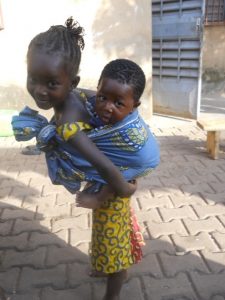
Burkinabe girl carrying her younger sibling
The rainy season is short, between July and September, and often poor rainfall means low yield, which translates to food insecurity for the Burkinabe. The Burkinabe men, having just that one responsibility of tending to the livestock or fields, can often be found congregating in the communal space and drinking. The only social interaction the Burkinabe women get is when they pound and grind millet with other women, thus even “down time” is over work. Women and girl children are responsible for caring for the young. Female children as young as 5 years old are involved in the care of their younger siblings.
BURKINA CUISINE
Food insecurity is one of many challenges that Burkina Faso faces, most Burkinabe eat at most two meals a day on a good day. Recent data estimate that 3.3 million people in Burkina Faso are facing acute food insecurity (August 2020) and more than 535,000 children under the age of five currently suffer from acute malnutrition (September 2020). A discussion of Burkina cuisine needs to be prefaced by this sobering information, as the cuisine, much like other resources, is sparse. The meals are modest, carbohydrate heavy, and often lacking in protein and variety.
Although Burkina Faso was under French colonial rule from 1895 until 1960, and this is reflected in the choice of official language, when it comes to influences on cuisine, it is predominantly West African with just a smidgen of French influences. Each of Burkina’s over 60 different ethnic and linguistic groups have variations in the recipes that originated within the tribe.
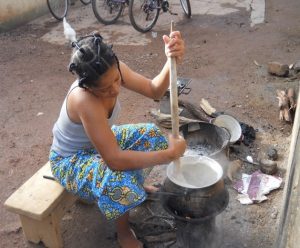
Burkinabe woman cooking Tô
The universal staple in Burkina is Tô (rhymes with Toh). Made of just two ingredients, millet flour (or corn meal or sorghum) and water, Tô is a very stiff paste that is sometimes shaped into balls or like a chunk of bread. Tô is served along with sauces or stews containing baobab leaves or okra or other such hardy greens. A groundnut paste known among the Burkinabe as shea butter is sometimes added to the stew. Pieces of Tô are broken off and spooned or dipped in the stew.
Meat is scarce and therefore cost prohibitive and reserved for special occasions such as weddings or holiday meals. In the more urban spots, “poulet-bicyclette,” a chicken dish, is served as street food. Literally translating to “chicken on a bicycle” this dish draws its name from the fact that it is sold by street vendors who bring it into town on their bicycles.
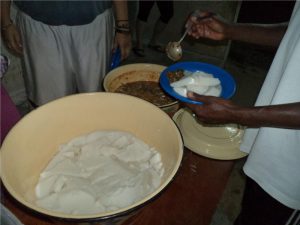
Tô served with stew
Babenda is a one pot greens and grains dish. Any hardy greens such as kale, chard, etc. are cooked with grains. The flavor for this dish comes from two other ingredients soumbala (or dawadawa) which is fermented locust beans and dried or smoked fish.
Riz Gras, literally “fat rice,” is another staple. Chicken pieces are stewed with tomato, onion, and chili pepper until it falls off the bone. The name comes from the amount of oil which gets added.
A spice mix that is used to flavor dishes is Kan Kan Kan. It is made by combining peanut powder, hot chili peppers, allspice, and bouillon cubes. (The Maggi brand of bouillon cubes is a mainstay in most West African kitchens.)
Some vegetables sold in markets and used in stews are French green beans, yams, okra, eggplant, sweet potatoes, onions, peppers, and tomatoes. Desserts are rare. Burkinabe eat fruits instead, such as bananas, mangoes, and grapefruits.
THE BURKINABE WAY OF LIFE
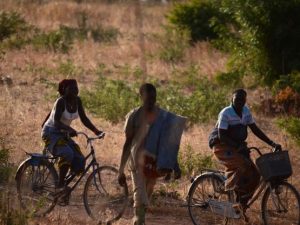
Common modes of transport
The Burkinabe way of life is a throwback to a predominantly rural, communal and simple way of life. Public amenities and infrastructure are lacking, making life in Burkina Faso physically demanding and challenging. There are less than 7,767 miles of roadways of which less than 1,242 miles are paved, all located around cities. Transport is predominantly by foot and to a much smaller extent, bicycle. Bushtaxis are vans that run on a limited schedule in some of the bigger villages like Sabse. Buses are another mode of transport that are available in some of the bigger villages. There is a single rail line that runs from Kaya to Abidjan in Cote d’Ivoire, via Ouagadougou, Koudougou, Bobo Dioulasso, and Banfora, which are the four main cities in the country. The only international airport is in the capital city, Ouagadougou.
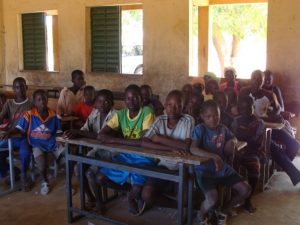
A school in Sabse, Burkina Faso
In theory schooling is mandatory between the age of 6 – 16 and free of charge. However, the lack of funding for providing this right to education means there is little actual ability for this to be true in practice. In rural Burkina Faso, school children have to walk a good two miles a day, on average, to school. “School” is often makeshift structures with only about one percent of schools having fully enclosed structures. With the violence and destruction of existing infrastructure that is ongoing in Burkina Faso, this is expected to only get worse.
Despite this very challenging state of affairs, the Burkinabe continue to be the honest, happy people they are known to be. “Paranthese a plaisanterie,” meaning all ethnic groups are connected and have to live in harmony for peace to reign, is the Burkinabe motto that underlies social cohesiveness. It was not uncommon for members of the same family to practice different faiths and for the Christian and the Muslim to live together without conflict.
Burkinabe, in better times when there wasn’t this striving to survive, love their beer and music. “Even if there is no money, there is money for beer,” so the saying goes. “Boug ninga sen dita taama segd n pussa sebga a zaame,” a Mossi tribe saying, translates to “the goat that eats shea must thank the wind that made it fall,” but is meant to emphasize the importance of being thankful. “O nisaalo pia taana lie a maa, o naa kan fidi hondi saani lie yena ba” is a Gourmantché tribe saying that translates to “man has two feet, but cannot go on two paths at the same time” and is used to stress the importance of being loyal and staying the course. The Gourounsi saying “Jinga didoua ba pè moum” translates to “one hand alone cannot collect flour” and gets to the heart of what the Burkinabe consider the cornerstone of what it means to be Burkinabe: unity and cooperation.
Sources:
Photo credit: Wendy Munyon. These images were captured during her time volunteering with the Peace Corps in Burkina Faso.
https://www.cia.gov/library/publications/the-world-factbook/geos/uv.html
https://www.britannica.com/place/Burkina-Faso#ref282544
https://blog.compassion.com/life-in-burkina-faso/
https://www.everyculture.com/Bo-Co/Burkina-Faso.html
https://www.diversitycan.com/tops.aspx?id=A-Meal-in-Burkina-Faso-Represents-More-Than-Just-Food-1145
https://www.nrc.no/news/2020/august/burkina-faso-record-displacement/
https://www.globalr2p.org/countries/burkina-faso/
Learn more about the unique nature of Tiebele’s Cour Royale, where every building is a canvas: https://www.dailymail.co.uk/news/article-2260910/African-village-building-canvas-house-palace-tomb-dead.html.
View Recipes from Burkina Faso
Burkina Faso
